The Kabbalah, the Tarot and the Middle Way
Kenneth Chan
13. Stabilizing the World of the Limitless
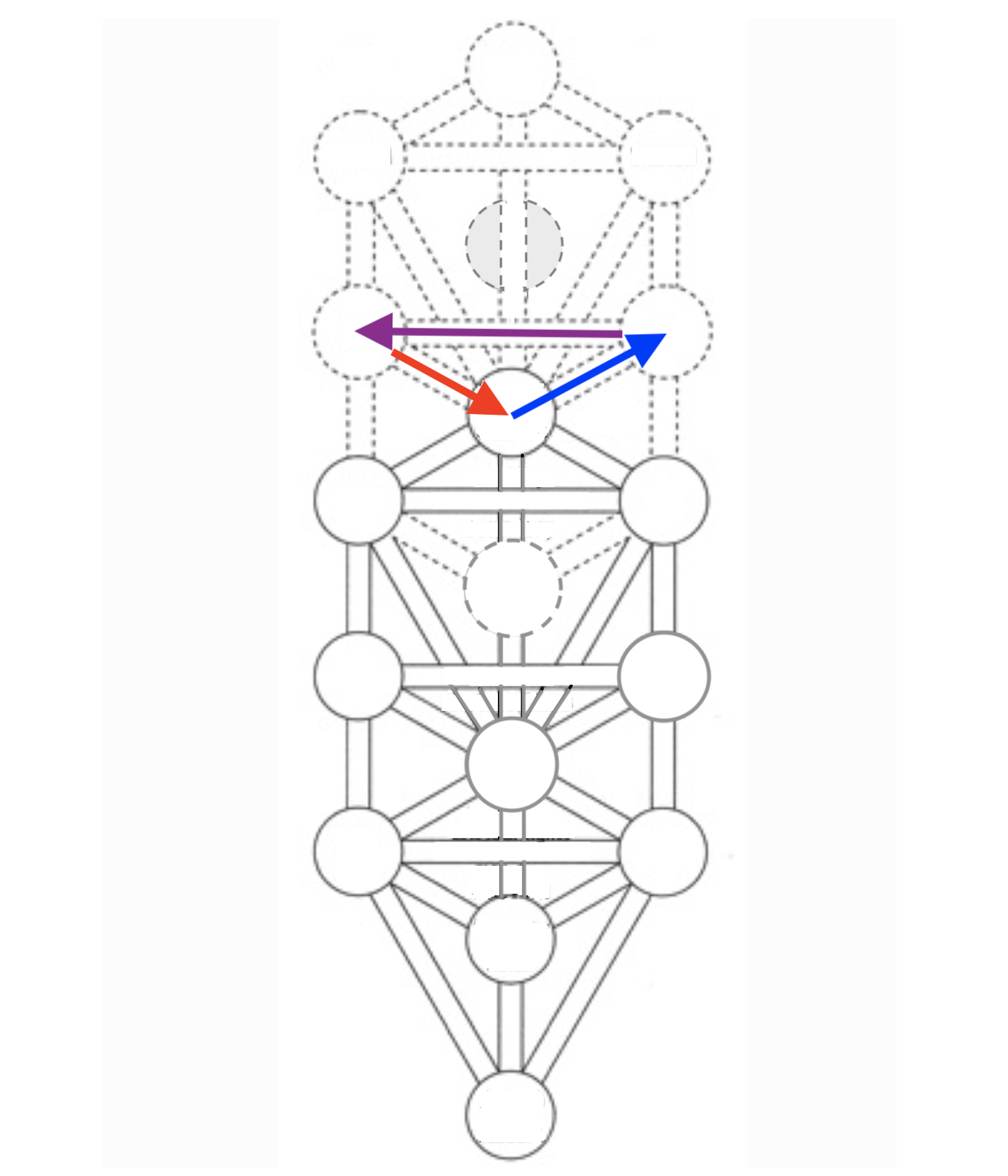
The three paths that form the primary circuit in Yetzirah—from Tiphareth to Chesed to Geburah and back to Tiphareth—serve to refine the state of realization in Tiphareth. The circuit has to be traversed many times, and each time the circuit is completed, we reach a higher level of realization.
What then needs to be done is to incorporate these higher realizational states in Tiphareth into our usual and routine state of mind. This process is akin to the bringing of the realizations obtained by a meditative state of mind into our post-meditation state. In other words, we need to have the realizations in Tiphareth transform our core reference perspective represented by Hod, which is our normal and routine state of mind, and make these realizations stable.
The path from Tiphareth to Hod in the World of Yetzirah is also the path from Kether to Binah in the World of Assiyah. Since it is part of Assiyah, it is a path depicted by a Hebrew letter and also has a Yetziratic text description, which is as follows:
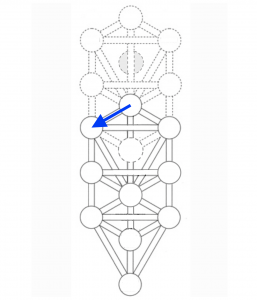
The 12th Path: Kether – Binah
“The Twelfth Path is the Intelligence of Transparency because it is that species of Magnificence called Chazchazit, the place whence issues the vision of those seeing in apparitions.”
Hebrew Letter: Beth. House.
Tarot Card: The Devil
Noble Eightfold Path: Right Effort
This path is the Intelligence of Transparency because it enables us to get past the obscuring fabrications and see things as they really are, even in our everyday waking state of mind. The name Chazchazit derives from the Hebrew ChZCh, a seer or seership. “That species of Magnificence called Chazchzit” essentially refers to this path’s ability to function as a Vizualizer that gives rise to the revelatory vision that Seers perceive. The words “seeing in appartitions” refers to the Seers’ ability to perceive that all things are empty of inherent existence and hence are like an apparition.
This is echoed in the words of Nagarjuna (from Chap 17, Verse 33 of the Mulamadhyamakakarika):
Mental afflictions, actions, and bodies,
As well as actors and results,
Are like cities of imaginary beings,
Like mirages, and like dreams.
A similar echo is found in the words of Shantideva:
That which is seen and that which is touched
Are of a dream-like and illusion-like nature.
Note that both Madhyamika masters, Nagarjuna and Shantideva, do not say that our reality is an illusion, but only that it is like an illusion. In other words, while things appear to an unenlightened mind as though they truly exist on their own right, independently, and from their own side, the truth is that they are all empty of inherent existence. Hence, they are like an illusion or like an apparition.

This path is also represented by the Tarot card, The Devil. The Devil is shown stupidly crouched over an unstable half-block, thus depicting the delusions that we are chained to. Note that the chains are loose around the people held captive by the Devil. These chains can be readily removed. This depicts the fact that we can free ourselves from our delusions if we have the will to do so.
That is why this path is designated by the Noble Eightfold Path as the path of Right Effort. It is the effort to free ourselves from our delusions. And the key delusion is the belief in an inherently existing “I” together with the obsessive self-cherishing that incessantly panders towards nurturing and promoting this “I” (that in reality does not inherently exist).
Note that this is a continuation of the path from Yesod to Tiphareth that is represented by the Tarot card, Temperance. In the path represented by Temperance, we are striving to bring the direct mystical experience of the loss of the sense of self into the realizational state of mind that we can generate even when we are not having a mystical experience. This is the realizational state of mind represented by Tiphareth. When Tiphareth has been sufficiently developed by repeatedly traversing the circuit—that runs from Tiphareth to Chesed to Geburah and back to Tiphareth—we can then set about striving to bring the realizations from Tiphareth into our usual, every-day, and post-meditational state of mind represented by Hod, thus making the wisdom, that realizes emptiness, even more stable and permanent.
This is then the process of Right Effort, the process of transforming our usual core reference perspective, represented by Hod, into a state of mind that perceives the emptiness of inherent existence of the self. This is how we “free ourselves from the Devil” which represent the delusions that keep us chained to a vicious cycle of suffering in samsara.
The Hebrew letter assigned to this path, from Kether to Binah, means house, which should be understood in relation to the Yetziratic text description of the path from Geburah to Binah, which names it the “Intelligence of the House of Influence.” Recall that the path from Geburah to Binah is essentially a path of renunciation of our self-centered worldly goals in life, and how together with the deepening sense of nonseparation, it leads to the motivation to work more for the benefit of the All. While that path, from Geburah to Binah, was assigned the Hebrew letter “fence” and was the intelligence of the house of influence, this path, from Kether to Binah, is now the actual house itself, which signifies an intensification of the conditions as well as the completion of all the factors that transform Binah. We are now not only within the “fence” but inside the “house” as well. From the structure of the Tree of Life, it is evident that this path represents the most powerful means of transforming Binah, since it comes directly from Kether.
This path from Kether to Binah is powerful in transforming Binah because it attacks the root delusion that gives rise to all our negative actions, actions that enchain us to samsara and its vicious cycle of suffering. It attacks the delusion that there really is an inherently existing self, the root delusion that then leads to all our negative self-cherishing thoughts and actions. It is this delusion of a truly existing “I” that leads to all the negative karma caused by anger, hatred, jealousy, greed, envy, and all our self-cherishing thoughts. Even the desire to possess more and more things stem from the idea that there is an actual “I” that can do the act of possessing. If we rid ourselves of this delusion of an inherently existing “I” we will truly be free of the devil. The evil that the devil represents can have no hold on us, because there will then be no basis for all the negative emotions and thoughts that can only function with the idea that there is an “I” to protect, to cherish, to be fighting for, and so on. That is why this path from Kether is the most powerful way to transform Binah.
Upon perfecting the paths from Geburah to Binah and from Tiphareth to Binah, Binah takes over the role of Hod. Just as Hod was the “mean of the Primordial,” the stabilizing focal point for the Tree of Life in Assiyah, Binah now has this role for the Tree of Life in Yetzirah. Hence the path that establishes Binah in this role is called “the Foundation of Excellence in the state of higher things.” This is reflected again in the Yetziratic text description for Binah:
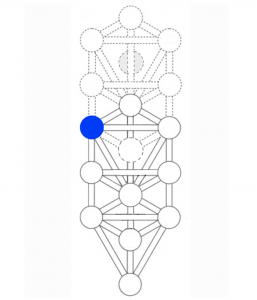
BINAH – UNDERSTANDING
“The Third Path is called the Sanctifying Intelligence, the Foundation of Primordial Wisdom; it is also called the Creator of Faith, and its roots are in Amen. It is the parent of faith, whence faith emanates.”
Spiritual Experience: Vision of Sorrow.
The faith here does not refer to blindly believing in something; it is faith in the sense of confidence in the spiritual path after having experienced the blissfully profound state in the mystical experience of Yesod, and after having found the clear logical reason for freeing ourselves from our root delusion following the realizations coming from Kether. It is faith that comes from verification, much the same way we have faith in scientific laws after they have been verified through scientific experiments. From Yesod, we have experiential verification, and from Kether, we have the realization of the true nature of reality that cuts away our root delusion, that keeps us from entering into the profound state of a union with the All. The transformed Binah is thus called “the Sanctifying Intelligence, the Foundation of Primordial Wisdom.”
The sense of nonseparation is a concomitant realization with that of the removal of the root of our delusions. While the paths from Geburah to Binah (in Assiyah) and from Tiphareth to Binah (in Assiyah) have the tendency of intensifying the sense of oneness, it is the more powerful direct experience of this oneness from Yesod in Yetzirah (or the revealed Daath of Assiyah) together with the logical realization of the loss of the sense of self, from Tiphareth in Yetzirah, that performs the final transformation of Hod (in Yetzirah) that makes it the “Sanctifying Intelligence, the Foundation of Primordial Wisdom” and “the Creator of Faith.”
The statement “its roots are in Amen” means that its link with Kether runs from Kether to Binah (Amen is a reference to Kether). The statement also emphasizes that the most important influence on Binah comes from Kether. This is a reflection of the situation found in Hod. Just as the highest ideals influencing Hod comes via Tiphareth, so the highest ideals influencing Binah comes via Kether.
Just as in the case for the World of the Limitless Light in Assiyah, there a stabilizing circuit in this World of the Limitless in Yetzirah. This stabilizing circuit works in a complementary way to the primary circuit in Yetzirah, and it runs from Tiphareth (in Yetzirah) to Hod (in Yetzirah), then from Hod to Geburah (in Yetzirah), and back from Geburah to Tiphareth. The path from Hod to Geburah is depicted by the Tarot card, The Hanged Man.
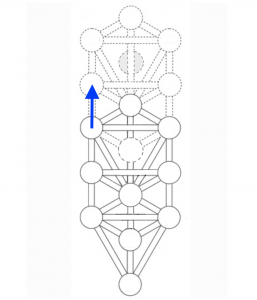
YETZIRAH: Hod – Geburah
Tarot Card: The Hanged Man
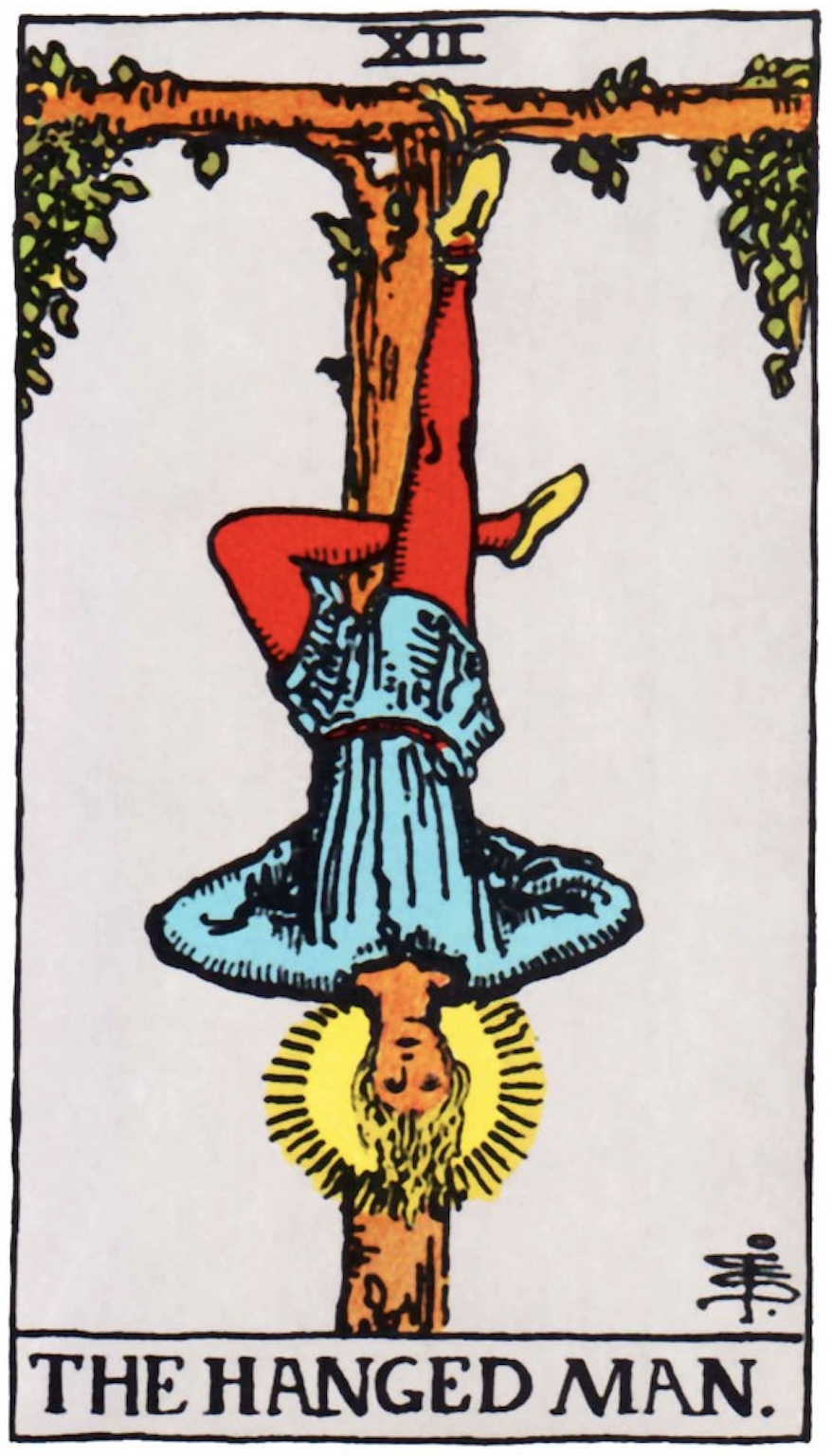
The Tarot card, The Hanged Man, shows a man hanging upside-down with an enlightened expression on his face surrounded by a glowing light. It depicts the path known in Tibetan Buddhism as “exchanging self for others.” This means that we replace the welfare of others as the primary concern, instead of the welfare of the self. That is why the hanged man is upside-down. He also has an enlightened expression on his face, because this is a higher state of spiritual realization, and he is at peace and in a state of bliss while maintaining this motivation of exchanging the self for others.
The Tibetan word for this process is Tonglen. Tong means “giving or sending”, and len means “receiving or taking.” It refers to the meditational practice of mentally giving all our happiness and benefits to others, while taking on all the sufferings and negativities of others upon ourselves. This, of course, is another aspect of the reversal of our usual mundane state of mind, and hence why the Hanged Man is depicted upside-down. The process is akin to that found in the Western mystical tradition where we learn “not to have, but to give.”
This path of reversing our usual prior state of mind, depicted by The Hanged Man, occurs as part of the repeated cycle from Tiphareth to Hod (of Yetzirah) to Geburah and back to Tiphareth. It is during repeated cycles of refinement of Tiphareth that we develop greater and greater degrees of exchanging self for others. It is a process that repeatedly develops finer and finer realizations of the loss of the sense of self together with the deeper and deeper sense of oneness and nonseparation.
This path then influences Geburah to further transform Tiphareth via the path depicted by the Tarot card, Strength, and by the Noble Eightfold Path, as the path of Right Mindfulness. The process of exchanging self for others would naturally reinforce the way realizations, that result in a more profound union with the All, subdue the forces of karma. Both would lead to a natural cessation of any tendency to harm others, and this is the real strength of the path from Geburah to Tiphareth. It is strength that comes from the natural subduing of the forces of karma through a transformation of our very being.
Eventually, when Tiphareth and hence Hod is sufficiently refined, we will have reached a level where there is no longer even the need to exchange oneself for others. We will then be ready to take the path from Geburah upwards to Binah of Yetzirah, where there is no longer the distinction between self and others, and we work simply towards the benefit of the One which is the union of all (i.e., the combination of self with others is now a natural condition, like the mixing of water with water).
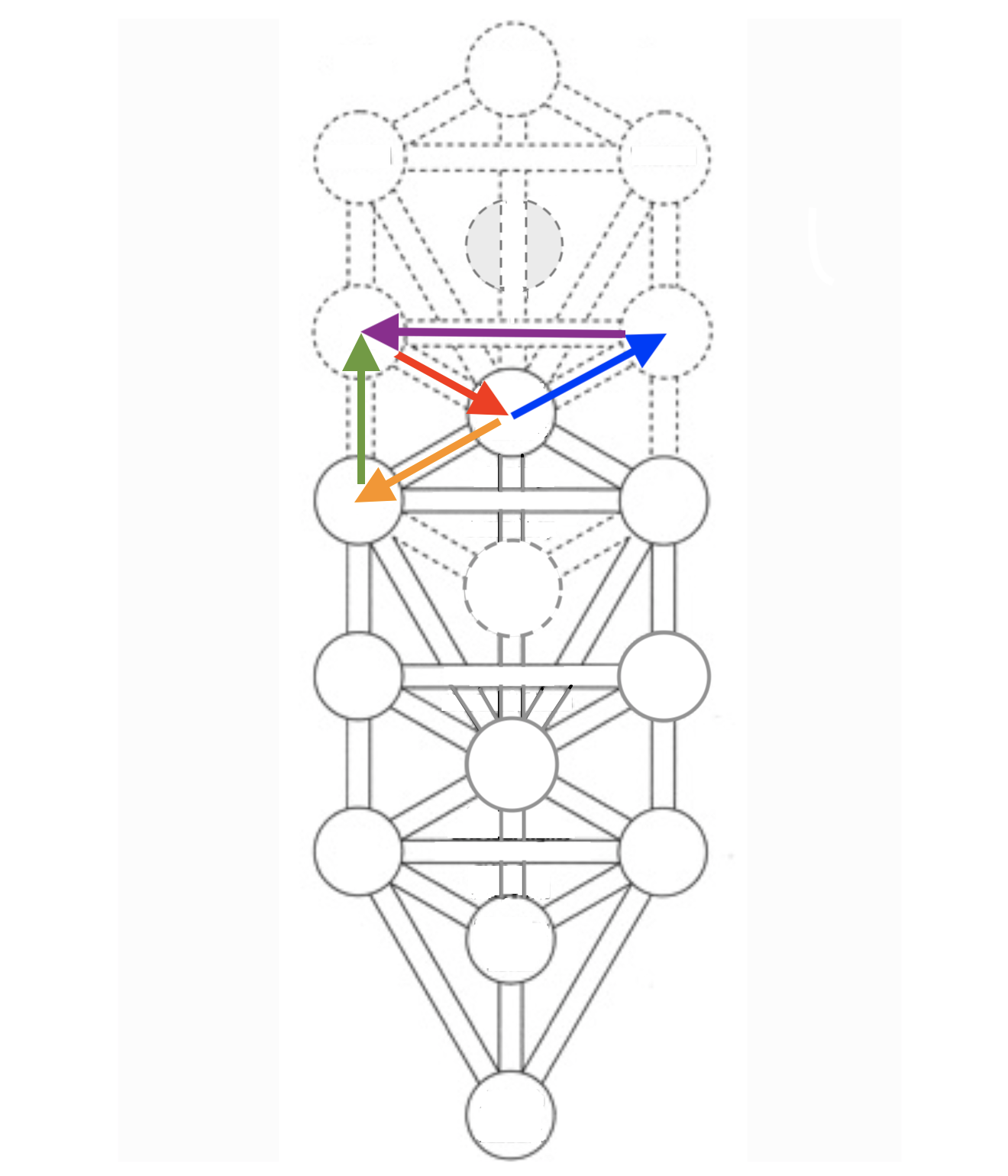
In summary, there are two circuits in the World of Yetzirah, similar to the situation in Assiyah, and both circuits are mediated by Tiphareth. The primary circuit links Tiphareth to Chesed, then to Geburah and back to Tiphareth. The stabilizing circuit runs from Tiphareth to Hod, and then to Geburah and back to Tiphareth. Both these circuits have to be traversed many times, each time further refining the spiritual qualities of both Tiphareth and Hod. Eventually, Hod will be sufficiently transformed for us to take the path upwards from Geburah to Binah, where we will then be working to replace Hod with Binah, which will then function as the new Hod in the higher Tree of Life in the World of Manifestation known as Briah.
Copyright © 2021 by Kenneth K C Chan. All Rights Reserved.